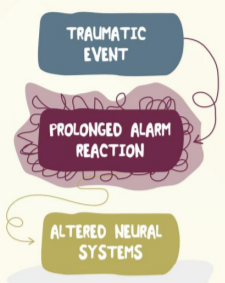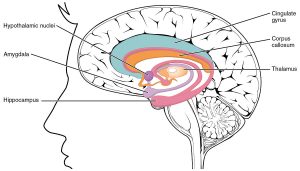3.2 Effects of childhood trauma on brain development

Just as positive experiences can assist with healthy brain development, children’s experiences with childhood trauma or other forms of toxic stress, such as domestic violence or disasters, can negatively affect brain development. This includes changes to the structure and chemical activity of the brain (e.g., decreased size or connectivity in some parts of the brain) and in the emotional and behavioural functioning of the child (e.g., over-sensitivity to stressful situations). For example, healthy brain development includes situations in which babies’ babbles, gestures, or cries bring reliable, appropriate reactions from their caregivers.
These caregiver-child interactions—sometimes referred to as ‘serve and return’— strengthen babies’ neuronal pathways regarding social interactions and how to get their needs met, both physically and emotionally. If children live in a chaotic or threatening world, one in which their caregivers respond with abuse or chronically provide no response, their brains may become hyperalert for danger or not fully develop. These neuronal pathways that are developed and strengthened under negative conditions prepare children to cope in that negative environment, and their ability to respond to nurturing and kindness may be impaired (Shonkoff & Phillips, 2000). The specific effects of maltreatment may depend on such factors as the age of the child at the time of the maltreatment, whether the maltreatment was a one-time incident or chronic, the identity of the abuser (e.g., parent or other adult), whether the child had a dependable nurturing individual in his or her life, the type and severity of the maltreatment, the intervention, how long the maltreatment lasted, and other individual and environmental characteristics.
Effects of Childhood trauma on Brain Structure and Activity
Toxic stress, including child maltreatment, can have a variety of negative effects on children’s brains:
Hippocampus: Adults who were maltreated may have reduced volume in the hippocampus, which is central to learning and memory (McCrory et al., 2010; Wilson, Hansen, & Li, 2011). Toxic stress also can reduce the hippocampus’s capacity to bring cortisol levels back to normal after a stressful event has occurred (Shonkoff, 2012).
Corpus callosum: The corpus callosum is the part of the brain chiefly responsible for interhemispheric communication and other vital processes, such as arousal, emotion, higher cognitive abilities. Preliminary evidence suggests that maltreated children and adolescents have decreased volume in the corpus callosum compared to non-maltreated counterparts (e.g., McCrory et al., 2010; Wilson et al., 2011).
Cerebellum: The cerebellum has been identified as being involved in the coordination of motor movements. Similar to the corpus callosum, the volume of the cerebellum has been found decreased when children have been exposed to maltreatment (McCrory et al., 2010).

Prefrontal cortex: Some studies on adolescents and adults who were severely neglected as children indicate they have a smaller prefrontal cortex, which is critical to behaviour, cognition, and emotion regulation (National Scientific Council on the Developing Child, 2012), but other studies show no differences (McCrory et al., 2010). Physically abused children also may have reduced volume in the orbitofrontal cortex, a part of the prefrontal cortex that is central to emotion and social regulation (Hanson et al., 2010).
Amygdala: Although most studies have found that amygdala volume is not affected by maltreatment, abuse and neglect can cause overactivity in that area of the brain, which helps determine whether a stimulus is threatening and trigger emotional responses (National
Scientific Council on the Developing Child, 2010; Shonkoff, 2012).
Cortisol levels: Many maltreated children, both in institutional and family settings, and especially those who experienced severe neglect, tend to have lower than normal morning cortisol levels coupled with flatter release levels throughout the day (Bruce, Fisher, Pears, & Levine, 2009; National Scientific Council on the Developing Child, 2012). Typically, children have a sharp increase in cortisol in the morning followed by a steady decrease throughout the day. On the other hand, children in foster care who experienced severe emotional maltreatment had higher than normal morning cortisol levels. These results may be due to the body reacting differently to different stressors. Abnormal cortisol levels can have many negative effects. Lower cortisol levels can lead to decreased energy resources, which could affect learning and socialisation; externalising disorders; and increased vulnerability to autoimmune disorders (Bruce et al., 2009). Higher cortisol levels could harm cognitive processes, subdue immune and inflammatory reactions, or heighten the risk for affective disorders.
Other: Children who experienced severe neglect early in life while in institutional settings often have decreased electrical activity in their brains, decreased brain metabolism, and poorer connections between areas of the brain that are key to integrating complex information (National Scientific Council on the Developing Child, 2012). These children also may continue to have abnormal patterns of adrenaline activity years after being adopted from institutional settings. Additionally, malnutrition, a form of neglect, can impair both brain development (e.g., slowing the growth of neurons, axons, and synapses) and function (e.g., neurotransmitter syntheses, the maintenance of brain tissue)(Prado & Dewey, 2012).
We also know that some cases of physical abuse can cause immediate direct structural damage to a child’s brain. For example, according to the National Centre on Shaken Baby Syndrome (n.d), shaking a child can destroy brain tissue and tear blood vessels. In the short-term, this can lead to seizures, loss of consciousness, or even death. In the long-term, shaking can damage the fragile brain so that a child develops a range of sensory impairments, as well as cognitive, learning, and behavioural disabilities. Other types of head injuries caused by physical abuse can have similar effects.
![]()
First impression of violence [14 min 43 sec]
Watch this video to understand the impact of child maltreatment on brain development. Please note that the clip contains themes and images that may be distressing to some. Please feel free to stop watching the video if you are distressed.
A transcript and Closed Captions are also available within the video.
References
Bruce, J., Fisher, P. A., Pears, K. C., & Levine, S. (2009). Morning cortisol levels in preschool-aged foster children: Differential effects of maltreatment type. Developmental Psychobiology, 51,14–23.
Hanson, J. L., Chung, M. K., Avants, B. B., Shirtcliff, E. A., Gee, J. C., Davidson, R. J., & Pollak, S. D. (2010). Early stress is associated with alterations in the orbitofrontal cortex: A tensor-based morphometry investigation of brain structure and behavioral risk. Journal of Neuroscience, 30, 7466–7472.
McCrory, E., De Brito, S. A., & Viding, E. (2010). Research review: The neurobiology and genetics of maltreatment and adversity. Journal of Psychology and Psychiatry, 51, 1079–1095.
National Center on Shaken Baby Syndrome. (n.d.). Physical consequences of shaking. Retrieved from http://www.dontshake.org/sbs.php?topNavID=3&subNavID=23
National Scientific Council on the Developing Child. (2010). Persistent fear and anxiety can affect young children’s learning and development (Working Paper 9). Retrieved from http://developingchild.harvard.edu/index.php/resources/reports_and_working_papers/working_papers/wp9/
National Scientific Council on the Developing Child. (2012). The science of neglect: The persistent absence of responsive care disrupts the developing brain (Working Paper 12). Retrieved from http://developingchild.harvard.edu/index.php/resources/reports_and_working_papers/working_papers/wp12/
Prado, E., & Dewey, K. (2012). Nutrition and brain development in early life. Retrieved from http://www. cmamforum.org/Pool/Resources/Nutrition-braindevelopment-early-life-ATTechnicalBrief-2012.pdf
Shonkoff, J. P. (2012). The lifelong effects of early childhood adversity and toxic stress. Pediatrics,129 (1), 232–246.
Shonkoff, J. P., & Phillips, D. A. (2000). From neurons to neighborhoods: The science of early childhood development. Washington, D.C.: National Academy Press.
Wilson, K. R., Hansen, D. J., & Li, M. (2011). The traumatic stress response in child maltreatment and resultant neuropsychological effects. Aggression and Violent Behavior, 16(2), 87–97.

